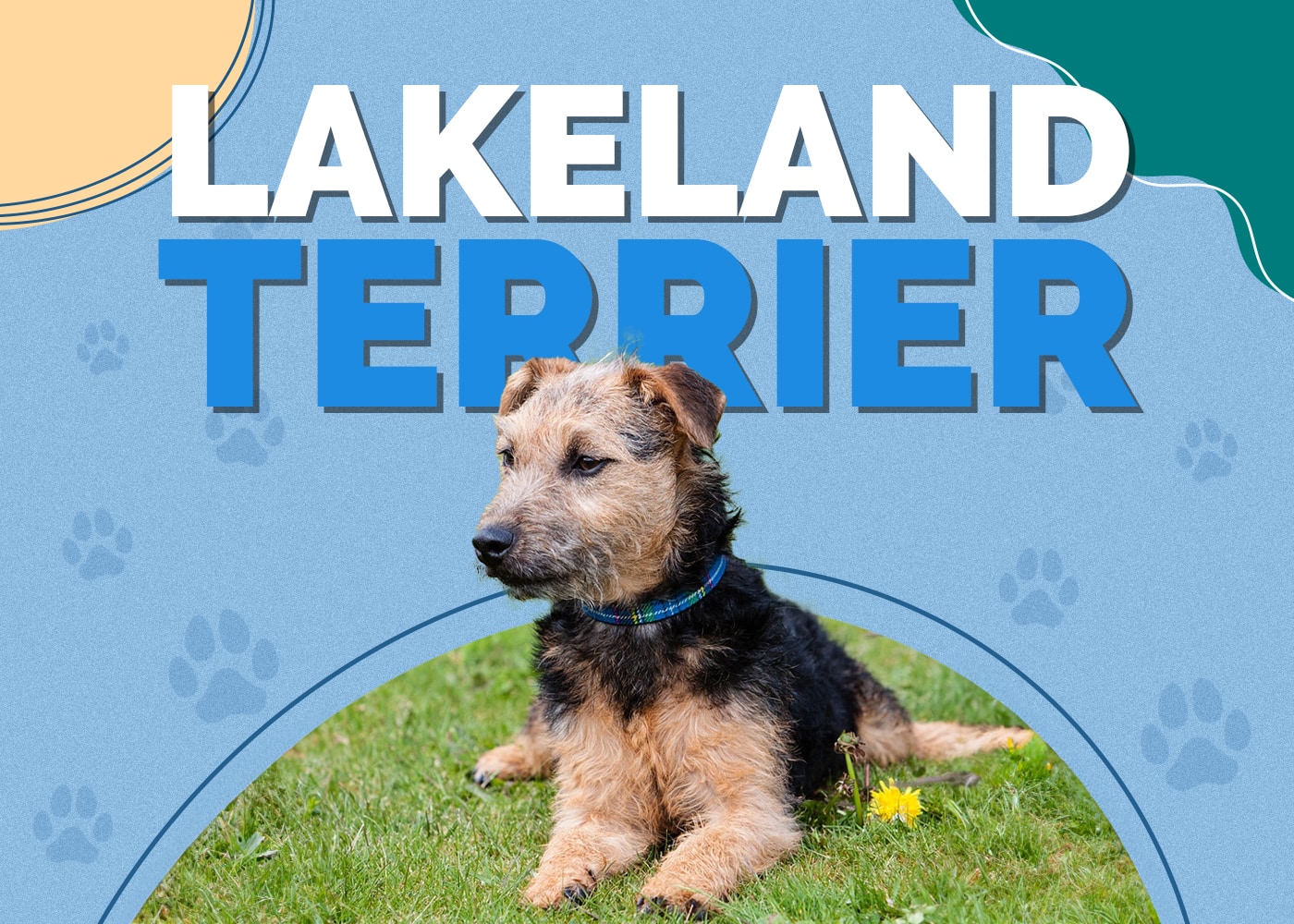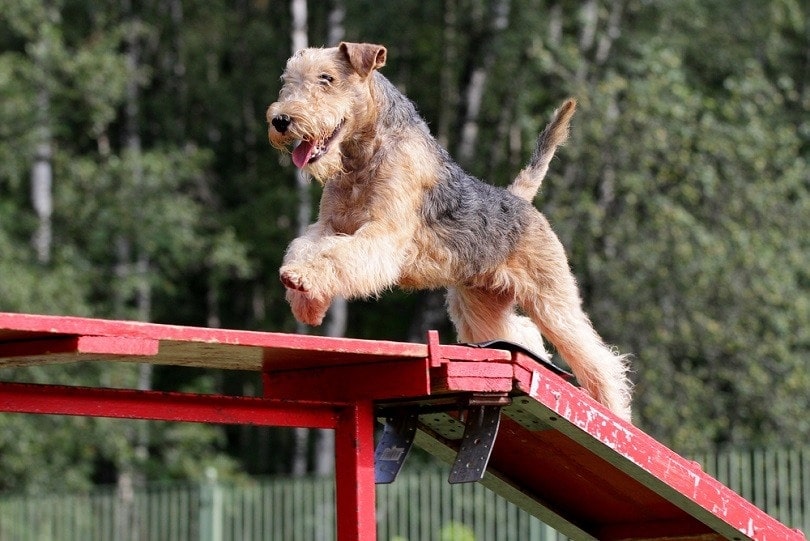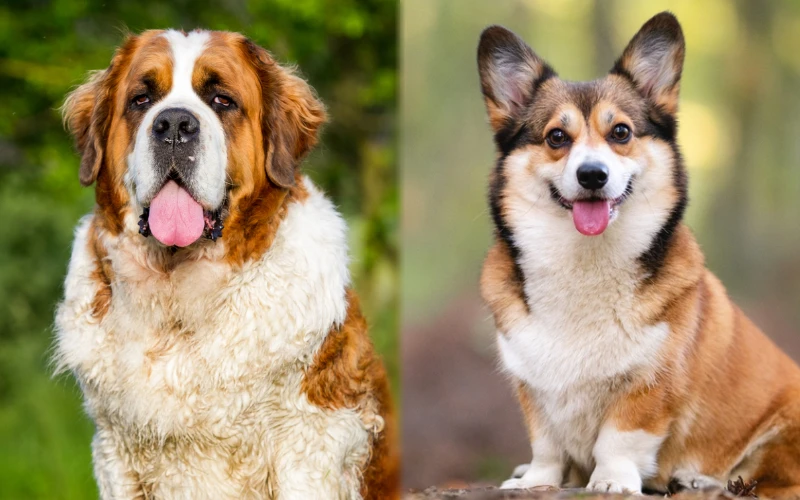Lakeland Terrier Dog Breed Info: Pictures, Traits & Facts

Updated on

| Height: | 13-15 inches |
| Weight: | 15-18 pounds |
| Lifespan: | 12-16 years |
| Colors: | White, black, black and tan, grey, blue, grizzle and tan, wheaten, red |
| Suitable for: | Active families, those looking for a low-shedding dog, outdoor enthusiasts |
| Temperament: | Alert, energetic, intelligent, willful, determined, playful, cheerful, loyal |
One of the rarest of the Terrier group, Lakeland Terriers are small, agile dogs with big, bold personalities. Originally bred for mines and farms, these cheeky dogs still maintain their workmanship attitude even as companions. Agile and athletic, Lakeland Terriers are less about the lapdog life and prefer being active throughout the day.
Lakeland Terriers may not be as popular as other Terrier breeds, but their courageous nature and quirkiness have won the hearts of many. Slowly rising in popularity once again, Lakeland Terriers are still listed as a threatened breed. Let’s take a look at this uncommon Terrier and what it takes to own one:
 Lakeland Terrier Puppies
Lakeland Terrier Puppies

Lakeland Terriers are a lesser-known breed that can be hard to find, which can drastically raise the price. When you look for this dog breed, make sure to take your tie to find a reputable breeder who puts the puppy’s health as a priority. A quality breeder should be able to provide information regarding the puppy’s health and show you the facilities and the puppy’s parents.
When you bring a Lakeland Terrier home, be ready to have a loyal and energetic dog in your family. They’re an excellent choice for active families who love to outdoors. These active dogs will need plenty of space and activities to burn their energy off.
3 Little-Known Facts About the Lakeland Terrier
1. Lakeland Terriers are low-shedding dogs.
Lakeland Terriers have two-layered coats that have a unique texture. Their wiry coats tend to trap loose fur, which can be removed by hand.
2. Lakeland Terriers are hard workers.
Lakeland Terriers may be companion dogs now, but they were originally bred for farmlands to chase off vermin and foxes. Because of this, Lakeland Terriers tend to bolt after smaller animals.
3. Lakeland Terriers are named after their place of origin.
Lakeland Terriers are named after the Lake District in England, going as far back as the 1900s. They became a recognized breed in the late 1920s.

Temperament & Intelligence of the Lakeland Terrier
Coming from one of the most dynamic dog breed groups, Lakeland Terriers are true Terriers with their bold and courageous personalities. Bred for working and hunting, Lakeland Terriers are quite energetic and can be too willful for first-time dog owners. These small hunters need purpose to stay happy, but their high levels of intelligence mean they get bored easily. Exercising your Lakeland Terrier daily is a must if you want your house and furniture to remain intact.
Lakeland Terriers are energetic, but they’re also fiercely loyal to their families. They thrive off of daily human interaction and affection. Early socialization with humans and animals is crucial, since Lakeland Terriers tend to be protective of their families. In fact, they make excellent watchdogs and will gladly bark at anything they deem an intruder.
Although they can be stubborn to the point of frustration, Lakeland Terriers are smart canines. They can learn a wide variety of commands and tricks, as long as the motivation is there. They can be trainable in the right hands, which is why they’re best for experienced dog handlers. Lakeland Terriers can excel in obedience, but they can be a handful for the average family.
Are These Dogs Good for Families? 👪
Yes, as long as there is someone who will take up the role as leader. Lakeland Terriers love Terriers families, but they usually “choose” a person to bond with. They can be suitable for families with smaller children, but their smaller frames make them more fragile than bigger dog breeds.
Does This Breed Get Along with Other Pets?
Yes, with other dogs, but early socialization is needed. Lakeland Terriers can do quite well with another dog in the house, especially if they’re raised together.
For households with smaller pets like cats and rabbits, we do not recommend this breed. Lakeland Terriers have a strong prey drive, so cats and small animals will be too tempting.

 Things to Know When Owning a Lakeland Terrier:
Things to Know When Owning a Lakeland Terrier:
Food & Diet Requirements 🦴
Lakeland Terriers are high-energy dogs that need a diet to support their daily activity levels. We recommend finding a dry kibble with at least 20% crude protein and a crunchy texture that helps keep teeth clean.
For more flavor and hydration, supplementing with wet food can be done. However, weight gain can be an issue with this breed. If you’re not sure what to feed your Lakeland Terrier, consult with your veterinarian for a more comprehensive diet plan.
Exercise 🐕
Exercising your Lakeland Terrier is essential to keep them content. A few brisk walks a day plus some time off-leash to roam in an enclosed area is a good start. They’re prone to wanderlust, so any off-leash play should be done in a fenced-in property.
Lakeland Terriers are athletic dogs with high levels of intelligence, opening the doors to various canine sports and activities. Consider taking your dog to a professional agility center, or you can find agility kits online to start at home. Because of their endless energy and tenacity, any sport or activity will be fun.
Mental exercises and mental stimulation are also important to incorporate everyday. Puzzle toys and hide-and-seek type games are great ways to keep your Lakeland Terrier’s mind sharp. These little dogs are incredibly clever, so make sure to change it up after a while.

Training 🦮
Training your Lakeland Terrier will take patience and confidence, as these dogs can sense weakness easily. They need a leader to follow or they’ll gladly become the boss. A consistent training schedule is crucial for terriers, with an emphasis on training daily.
Positive reinforcement training with a mixture of low and high value treats is recommended, while avoiding harsh training methods. It’s especially important to avoid yelling or angry reactions, since these dogs will grow resentful of you. Lakeland Terriers are determined dogs and are prone to wandering and chasing, so recall training needs to be a priority.
Group training classes can be a great option if you’re also looking for a way to socialize your new Lakeland Terrier. These little dogs are clever and can excel with a confident leader, but they may not be as eager as other dog breeds. If your Lakeland Terrier seems to be struggling to focus with group classes, one-on-one lessons with a professional trainer is recommended.
Grooming ✂️
Lakeland Terriers have double coats that need to be hand stripped on a weekly basis. Hand stripping is a great way to prevent excessive shedding, though Lakeland Terriers rarely shed much.
In addition to hand stripping, brushing out the coat helps promote normal oil production and removes any tangles or knotting. Once a month or so, a trip to the groomer to trim the coat will be needed.
Lastly, your Lakeland Terrier’s nails should be trimmed on an as-needed basis or roughly every 4 weeks. If you’ve never trimmed a dog’s nails, we recommend going to a professional groomer and they can teach you how to safely do it at home.
Health and Conditions 🏥
Lakeland Terriers are known for being a hardy, healthy breed with a long lifespan and few major health conditions. While this may be true, it’s important to prepare for the future in case your dog’s health changes. Here are the most common health conditions of Lakeland Terriers:
- Lens Luxation
- Cataracts
- Obesity
- Patellar Luxation
- Dental decay
- Hip Dysplasia
- Legg-Perthes Disease
- Von Willebrande’s Disease
 Male vs Female
Male vs Female
Male and female Lakeland Terriers are similar in personality and temperament but vary slightly in size. Males are usually bigger than females, but only by a few pounds. Aside from a size difference, there are no major reasons to choose a male or a female. The decision should be made with all parties involved.
 Final Thoughts
Final Thoughts
Lakeland Terriers are small in size, but they’re anything but lapdogs. These little hunters are great for individuals and families that can spend time with them and bring them along on family outings and adventures. With daily exercise and a calm, confident leader, Lakeland Terriers will easily become part of the family.
If you’re looking for an active, energetic dog breed in a small, compact body, the Lakeland Terrier will exceed your expectations. For others looking for a calmer, more companionable dog, we recommend looking at other breeds for a better fit.
Related Reads:
Featured image credit: ivkatefoto, Shutterstock
 Lakeland Terrier Puppies
Lakeland Terrier Puppies
 Things to Know When Owning a Lakeland Terrier:
Things to Know When Owning a Lakeland Terrier: Male vs Female
Male vs Female Final Thoughts
Final Thoughts








